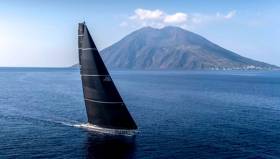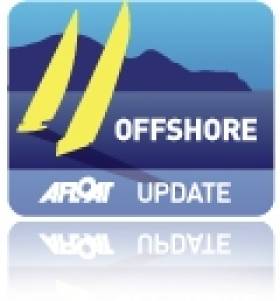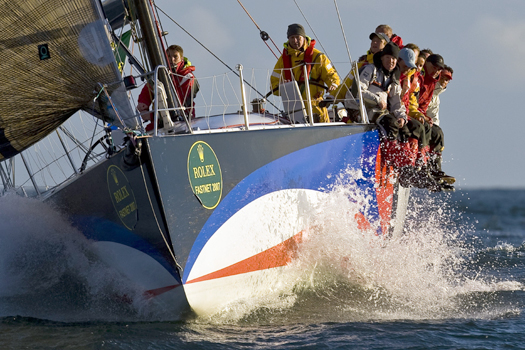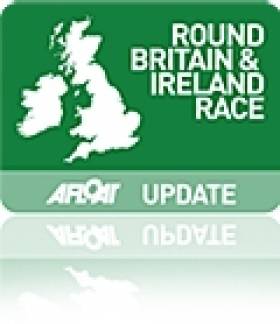Displaying items by tag: Brian Flahive
Middle Sea Race: Hugo Boss Makes Superb Work of Tricky Conditions, Rambler Recovers From Being Stuck at Stromboli
Everyone going into the 608-mile Rolex Middle Sea Race knows they will experience a challenging course with weather which can be anything and everything from extended calms to surprisingly vicious gales, and the 2017 edition is no exception writes W M Nixon
In mostly light easterly winds after the start on Saturday, the fleet’s stately progress saw George David’s Rambler 88 give a master-class in taking full advantage of every new if small improvement in wind strength, and she lengthened away from the likes of the 100ft Leopard and the 98ft CQS in impressive style, only to see it evaporate again as she was invariably the first one into the next belt of calm.
However, she was always in the lead, and was on the up and up approaching Stromboli yesterday, only to find things very flat beyond that splendid turning point. Increasing desperate to find breeze anywhere, and always looking to be first into the much-forecast strong to gale west to norwest wind which was expected last night, she crawled along at barely a knot and ended out somewhere about nor’nor’east of Stromboli, taking a very wide turn before she began to feel the first of a new air. This eventually became the breeze which gave her a long tack/short tack beat to the next turn at the island of Favignana west of Sicily’s most westerly headland.
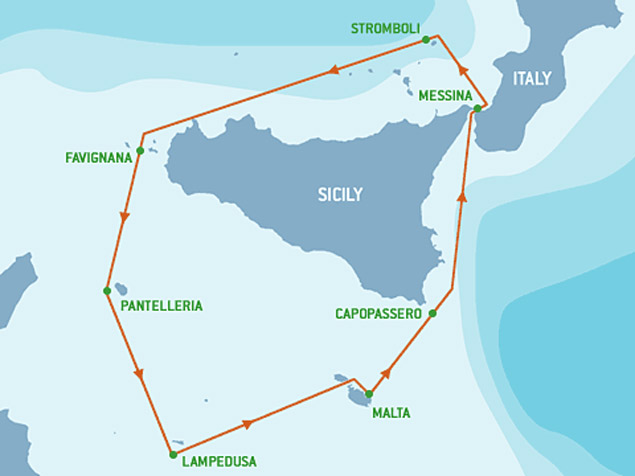 The 608-mile Rolex Middle Sea Race has a bit of everything – and sometimes a lot of wind. Rambler is now on the Pantelleria-Lampedusa stage, tearing along at up to 26 knots in a mighty west to northwest wind.
The 608-mile Rolex Middle Sea Race has a bit of everything – and sometimes a lot of wind. Rambler is now on the Pantelleria-Lampedusa stage, tearing along at up to 26 knots in a mighty west to northwest wind.
It was the IMOCA 60 Hugo Boss (Alex Thompson & Nin O’Leary) which went most determinedly to the northwest. They’d actually arrived at Stromboli at a time when a neat rounding had become possible, but knowing their very special boat’s notable lack of enthusiasm for tacking duels and windward work generally, they slugged on for many miles on port tack until they could hope to lay Favignana without having to tack again.
It was a tactic which worked a treat, and now while the bulk of the fleet are still bashing it out in rugged weather north of Sicily, Hugo Boss is screaming along at 24 knots and more from Favignana towards the next turn at Pantellaria, third on the water to Leopard which is slower at 22 knots, while Rambler is already past Pantellaria and making 26 knots for Lampedusa, the final turn before the finish at Valetta.
The speeds being achieved by the three leaders could well invert the leaderboard’s former emphasis in smaller craft, which still have an awful lot of hard sailing to Favignana before they can let rip. Otra Vez (Brian Flahive & Sean Arrigo) had been well placed in the two-handed division, but now seems to signal retirement, however Xp-ACT with Barry Hurley and Shane Diviney in her crew is well-placed for the Favignana rounding, while Conor Doyle’s chartered Hydra has also made good progress along Sicily’s north coast.
But having seen small boats dominate the top placings early on, we now have the fascinating prospect of the three leading biggies carrying the strong favourable winds all the way to the finish at enormous speeds, and turning the results upside down.
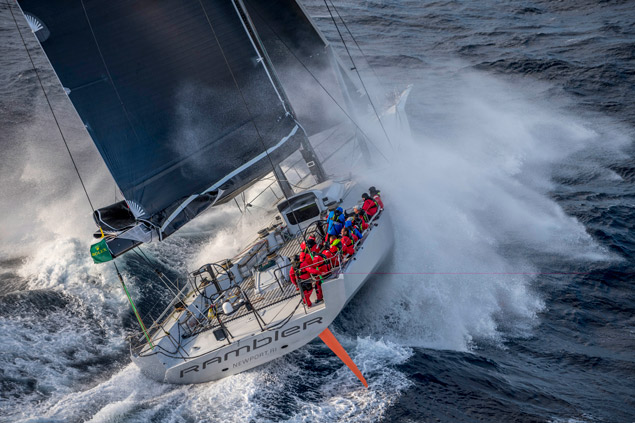 Here we go……Rambler starts to free off as she weathers Favignana at eight o’clock this morning. Photo: Kurt Arrigo
Here we go……Rambler starts to free off as she weathers Favignana at eight o’clock this morning. Photo: Kurt Arrigo
Tracker here
Round Britain & Ireland Tale For Poolbeg Y&BC & Wicklow Sailing Club
#srbi – Irish offshore sailors Liam Coyne and Brian Flahive will relive their stunning Round Britain and Ireland voyage next Wednesday night at 8pm in Poolbeg Yacht Club on the River Liffey. In the same week the pair will deliver the talk again on Friday night at Wicklow Sailing Club at 8pm. It's a chance for those that missed the first sell out talk at the National Yacht Club last October to hear about one of the stand out offshore victories of 2014.
For twelve days, Ireland's sailing and maritime community followed with bated breath while the fortunes of Liam Coyne and Brian Flahive with the First 36.7 Lula Belle waxed and waned in the storm-tossed 1802-mile RORC Sevenstar Round Britain & Ireland Race. Read the full story here.
Coyne and Flahive were awarded Afloat sailor of the month awards for the achievement in September.
Irish Sailing Review 2014: A Year Of Hope, Regeneration & Success
#irishsailingreview – 2014 has been the year in which Irish sailing regained its international confidence afloat by re-capturing the Commodore's Cup. Having won it in 2010, the national economic collapse prevented any defence in 2012, but in July 2014 the stain and shame of 2012's non-appearance was emphatically wiped from memory with a convincing team victory led by Anthony O'Leary.
Ashore meanwhile, it had taken longer in some quarters for the economic realities to become fully evident and accepted. But for the Irish Sailing Association, a grassroots revolution within the national authority and sailing in general in 2014 resulted in a root-and-branch analysis of the workings of the Association, which had been heading towards financial disaster through a combination of over-staffing, grandiose schemes of expansion and empire-building, and an emphasis on activities and programmes which were remote from the needs of ordinary sailors throughout Ireland.
It took six months to turn round the course of the Association. But on November 5th 2014 the new ISA President, David Lovegrove, was able to announce a far-reaching re-structuring which is already resulting in a leaner and fitter body, better able to provide a realistic service for clubs and the huge diversity of recreational activity on Ireland's seas and lakes.
While all this high profile activity and action has been taking place at international and national level, those Irish sailors who had managed to keep up their sport through the financial downturn – albeit in often very reduced circumstances – continued to sail their boats with the attitude that, while the economic situation was disastrous, it mustn't be allowed to become serious, and in some ways the best course out of the recession was to sail through it. W M Nixon casts an eye over the year's main activities.
In the Irish sailing year, Christmas Day is New Year's Eve. Next morning, on December 26th – St Stephen's Day or Boxing Day or whatever you're having yourself – the annual 628-mile Sydney-Hobart Race starts. It may be on the other side of the world, and it may still be in the very last days of the old year. But Irish interest at home and in Irish-Australia is always high, and in the sailing community it's seen as the start of the new season.
December 26th 2013 was in line with this, as we'd ex-Pat superstar Gordon Maguire – a previous Hobart race overall winner – very much in contention with Matt Allen's totally new Carkeek 60 Ichi Ban, we also had Sean McCarter of Lough Swilly YC skippering Derry/Londonderry in the warmly-welcomed Clipper Fleet of 70-footers designed by Tony Castro (formerly of Crosshaven) which were taking in the Hobart race as part of their global circumnavigating race, and we'd Barry Hurley and Kenny Rumball on the First 40 Breakthrough knowing that in the 2010 Hobart race, the new design's race debut, First 40s had taken first and second overall.
In a rugged race in which the wind got up to gale force and more towards the end, it was a much-loved hundred footer, Bob Oatley's continually-modified Wild Oats XI, which stole all the headlines with line honours, a course record, and a class win. Irish hopes were best met by Sean McCarter, who logged a very clear win in the Clippers. As for Ichi Ban, while she was third in IRC Div 1 and 8th overall, it wasn't quite a stellar performance, reinforcing the views of those of us who think the boat may be just a little too plump by today's lean and hungry standards. And aboard Breakthrough, they'd 8th in class and 29th overall, a useful performance perhaps, but Barry Hurley will be back on December 26th 2014, boosted by his first in class and second overall in October's Middle Sea Race.
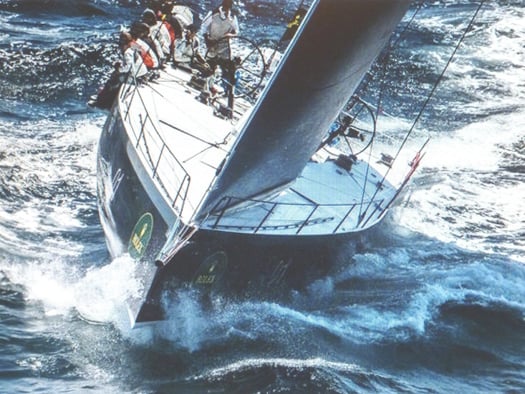
Matt Allen's Ichi Ban in the Rolex Sydney-Hobart Race of 2013, with Gordon Maguire as sailing master. To some observers, the very new Carkeek 60 seemed distinctly plump in her hull form forward compared to her closest competitors
In late January 2014, attention focused on the Quantum Key West Regatta in the Florida Keys, where Irish Olympic sailor Peter O'Leary of Cork was on the strength of New York art dealer Marc Glimcher's completely new and very potent looking Ker 40 Catapult. The boat did the business afloat in Florida, but further business was done ashore, as Anthony O'Leary himself was in Key West to see if he could sign up Catapult to be the secret ingredient in Ireland's Commodore's Cup team, for which at that stage the only certainty was his own older Ker 39 Antix. There seemed to be agreement, but in the volatile world of international trading and snap decisions in which top modern sailing operates, there can be sudden reversals of fortune, and O'Leary later admitted that until Catapult was actually unloaded from a ship in Europe, he hadn't been a hundred per cent certain she'd show.
Key West had further Irish interest in that veteran skipper Piet Vroon's Ker 46 Tonnere de Breskens – a former Round Ireland Race winner – was another star in the show, but much was to happen in Irish sailing before the Round Ireland 2014 got under way in Wicklow on June 28th.
With March slowly showing signs of Spring, university racing came centre stage, and it was University College Dublin which came through on top to qualify as Ireland's representatives in the Student Yachting Worlds in France in October, the team led by Philip Doran.
Another team was emerging as the Irish Cruiser Racing Association (ICRA) announced that our Commodore's Cup squad would be Anthony O'Leary's Ker 39 Antix, Marc Glimcher's Catapult, and the Grand Soleil 43 Quokka chartered by Michael Boyd and Niall Dowling, with Anthony O'Leary as team captain. He in turn would be supported by the shore management team, for a very intense week of racing, of Barry Rose and Fintan Cairns, with Mike Broughton in what would prove to be the particularly onerous task of Team Meteorologist.
As 2014 was exactly midway between two Olympiads, top level international dinghy sailing to Olympic standards might have been expected to be on the back burner. But Ireland's Olympians were very much on track on the international scene, and busy with their own programmes which culminated in the ISAF Worlds in Santander where Olympic places in Rio de Janeiro for 2016 were secured by James Espey in the Laser, Ryan Seaton & Matt McGovern in the 49er, and Annalise Murphy in the Women's Laser Radial. All were of course also seen in other boat types from time to time, with Annalise in particular bringing some glamour to the growing class of foiling Moths in Ireland.
Annalise on the foiling Moth
Other top international women sailors had descended on Ireland in early June with the ISAF Women's Match Race Worlds at Crosshaven. It's very much a specialist sailing interest, but aspiring Irish woman sailors attracted to this discipline found that this successful regatta provided some very useful networking contacts and future crewing possibilities, while the racing itself saw Sweden's Anna Kjellberg of the Royal Gothenburg YC become the new champion after defeating Camilla Ulrikkeholm of Denmark in the final.
In an entirely different area of sailing and life afloat, the traditional boat scene had come early to life with the Baltimore Wooden Boat Festival at the end of May. In the Irish climate after a particularly damp Spring, it reflected great credit on those involved that there was such a good turnout, ranging from the Shannon Gandelows from Limerick recently returned from their historic visit to Venice, through the many restored classic yachts of the region, also including the lovely Shannon cutter Sally O'Keeffe from Kilrush, and going on into the restored traditional mackerel and lobster yawls which make West Cork their home.

Shortly after their historic visit to Venice, the Shannon gandelows built by the Ilen School took part in the Baltimore Wooden Boat Festival at the end of May. The gandelow here, rowed by Liam O'Donghue, Anthony Kenny and Robert Samlle, is headed across Baltimore Harbour towards the gaff ketch Sile a Do.
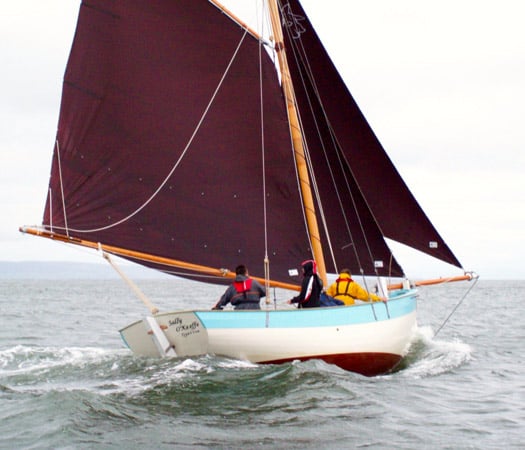
The pride of the Shannon Estuary - Sally O'Keeffe was built in a community effort in Querrin on the Loop Head peninsula.

The traditional lobster boat Saoirse Muireann (left, Cormac Levis) and the mackerel yawl An tiscaire (Uilliam O'Lorcain) are a familiar sight in the waters of West Cork. Photo: Brian Marten
They were to re-appear in even greater numbers at the Ballydehob Gathering of the Boats in early August, a month during which the classic Galway Hookers of the West Coast were at their busiest on their home Atlantic waters, but the East Coast also had its moments with the Riverfest in Dublin's Liffey in early June seeing traditional and classic craft in a lively mix.

Sails in the City – two of the 1898 Howth Seventeens racing in the heart of Dublin in the Liffey Riverfest. Photo: W M Nixon
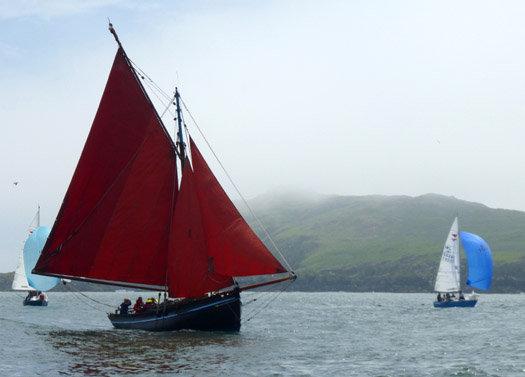
It could almost be Connemara, were it not for the Puppeteer 22s – the Galway Hooker Naomh Cronan in the new Classics & Traditional Division in Howth's annual Lambay Race, which was marking its 110th anniversary in 2014. Photo: W M Nixon
Indeed, so strong is the growing interest in classics and trads on the East Coast that to celebrate the centenary of the Lynch family's Howth 17 Echo (one of the newest of the class, the most senior ones were built in 1898) Howth YC provided a traditional Lambay Race course – simply up around Lambay and back to Howth Harbour – for the Seventeens and a new Classics Division, with the Howth 17s seeing the first two places taken by 1898 boats – Rita (John Curley & Marcus Lynch) and Aura (Ian Malcolm) – while Old Gaffers Association International president Sean Walsh won the classics with his Heard 28 Tir na nOg from the Clondalkin team's Galway Hooker Naomh Cronan. As for the overall prize among the large fleet of more modern boats sailing their more complex course, that was won by Colm Bermingham's Bite the Bullet.
The countdown to the Commodore's Cup had continued with inspirational performances by Anthony O'Leary in the Easter Challenge in the Solent, where he won his class with Antix, and then in June he did the same again with the British IRC Championship. Back home, ICRA held their Nationals with the Royal Irish YC in Dun Laoghaire in mid-June, and out of a fleet of a hundred plus boats it was the vintage Marcus Hutchinson/Rob Humphreys designed Quarter Tonner Quest (Jonathan Skerritt, RIYC) which was best overall scorer, a notably impressive performance also being put in by the Ker 36 Jump Juice (Denise Phelan) from Crosshaven.

The 27-year-old Quarter Tonner Quest (Jonathan Skerritt) was overall winner in the ICRA Nats at the RIYC in Dun Laoghaire. Photo: David O'Brien

Downhill battle at the ICRA Nats with the Mills 36 Raptor (ex-Aztec) in foreground, while beyond is Peter Dunlop of Pwllheli's J/109 Mojito against the XP33 Bon Exemple (Colin Byrne, RIYC). Photo: Davd O'Brien

The Ker 36 Jump Juice (Denise Phelan) dominated Class 0 at the ICRA Nats. Photo: David O'Brien
The end of June, and it was Round Ireland time. Thirty-six boats started from Wicklow, 33 finished in a race which was mostly on the slow side, with mid-size boats having their day. The winner was Richard Harris's Sydney 36 Tanit from Scotland by just six minutes from the home favourite, Liam Shanahan's J/109 Ruth from the NYC in Dun Laoghaire. The French defending champion, Laurent Gouy's Ker 39 Inis Mor which sails in Ireland under the burgee of Clifden Boat Club, placed third while Frank Doyle of Cork, second generation round Ireland aristocracy as son of Denis of Moonduster fame, was fourth with his A35 Endgame.
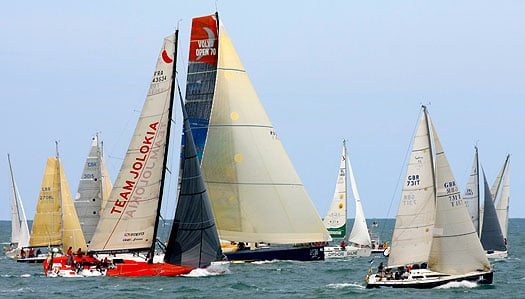
The start of the Round Ireland Race 2014 well illustrates the eclectic nature of the fleet. In right foreground is Richard Harris's Sydney 36 Tanit which was overall winner by just six minutes from the J/109 Ruth (Liam Shanahan), just beyond with the black jib, while the Volvo 70 Monster Project (David Ryan) comes thundering through the fleet at the beginning of a performance whch would see her take line honours win and thd class win in the CK Div.. Photo: Kevin Tracey
The same weekend as the Round Ireland race started, Lough Foyle sent the Clipper Fleet on their way after a week's festivities in Derry/Londonderry, made even more festive by the fact that Sean McCarter and his crew with the home town's boat had crowned their win in the Sydney-Hobart race with victory in the Transatlantic leg to Derry.
Clipper fleet in Derry
Crosshaven fairly leaped to life with Cork Week in July, and after several hitches in various boat-shipping plans, it was notable as the first time the Irish Commodore's Cup Team 2014 were seen together, and mighty impressive they looked too, with Quokka proving best on the Cork Week leaderboard.
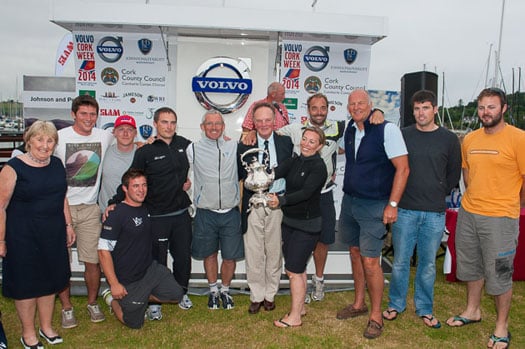
Michael Boyd (centre behind cup) and his Quokka crew, a member of Ireland's Commodore's Cup team, were overall winners of Cork week 2014. Photo: Bob Bateman
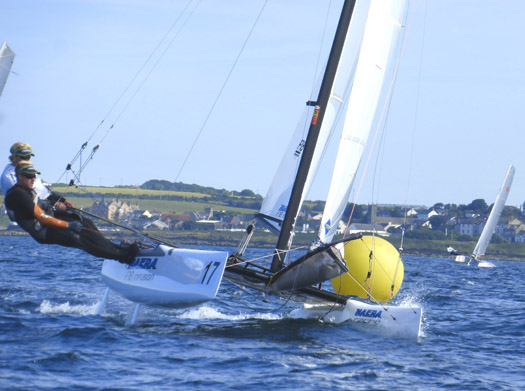
In the F18 Worlds at Ballyholme, Dutch skipper Gunnar Larssen (crewed by Ferdinand van West) is seen here putting in the smooth performance which saw him winning the worlds at his thirteenth attempt. Photo: W M Nixon
While all this excitement in racing boats with lids was building on the south coast in July, up north on Belfast Lough at Ballyholme the F18 Worlds were held for one of global sailing's most popular catamaran classes. Though the entry of 56 boats didn't match the 150-plus entries they get when the class has its worlds in its Mediterranean heartlands, the sailing was good and a popular winner emerged in longtime F18 sailor Gunnar Larsen, who is Dutch despite his Scandinavian name.
Dinghy attention was also very closely focused on Dublin Bay, with an enormous fleet of Optimists at the Europeans hosted by Royal St George YC from 12th to 20th July, and Dun Laoghaire really showing what it can do in being a major international regatta centre. France's Enzo Balanger was tops from Sweden's Kasper Nordenram, while best of the Irish in the Gold Division was Royal Cork's James McCann in tenth – not surprisingly, he was to go on to win the Nationals at his home club in August.

Nations from across Europe and beyond were at the Optimist Euros at Dun Laoghaire

Finn Lynch racing at Douarnenez in France where be became the new U19 Laser Standard world championPhoto: Trevor Millar/Sail Coach
On the broader international scene, former Opty stars Finn Lynch (National YC) and Seafra Guifoyle (Royal Cork) were to turn in outstanding results during 2014, with Guilfoyle firmly in the frame through the ISAF Youth Worlds in the Laser, eventually coming home from Tavira in Portugal with the Silver, while Finn Lynch was on top form to clinch the Gold in the Under 19 Laser Standard Worlds at Douarnenez in Brittany.
Back aboard the boats with lids, late July had brought the Commodore's Cup in the Solent, and if anyone out there doesn't know who won, we'd like to hear from them, as the state of total seclusion which this implies is surely something which could be packaged and marketed to our hyper-informed and over-crowded world. The comprehensive Irish victory just seems better and better with the passage of time, and for Anthony O'Leary it was the highlight of a fantastic season which in September was to see him win the Helmsman's Championship of Ireland (admittedly by just a whisker) in J/80s in Howth to set up a national double for Royal Cork, as young Harry Durcan of Crosshaven was winner of the Junior Helmsmans. O'Leary meanwhile went on to win the 1720 Nationals in Baltimore later that month, and then in November his beloved Antix was named RORC Yacht of the Year.

Antix in the Commodore's Cup, hanging in well coming to the weather mark to stay ahead of the newer Ker 40 Cutting Edge. Photo: Rick Tomlinson)
Even as Antix and her team mates were racing on towards glory in the Solent, in Clew Bay the West of Ireland Offshore Racing Association (WIORA) were staging their annual championship at hospitable Mayo SC, and it saw a good spread of results, with the overall winner being Galway's Liam Burke with his Corby 25 Tribal, while the runner-up was the McGibneys' Dehler Optimum 101 Dis-a-Ray, which sails under the Foynes YC burgee, but her home port is Tarbert further west along the Shannon Estuary.
August was busy with events for enjoyment. Eighty boats raced in Calves Week in West Cork, which has now been compressed to a four day regatta which means, as one sage family man observed, that you can take a house in Schull for a week's holiday, and then just as the wife and kids are getting fed up with having the ould fella always about the place, doesn't he absolutely have to go off and spend the last four days of the holiday sailing with his mates? That one of the top boats was Colman Garvey's True Penance maybe says it all.

Calves Week 2014 entries were up 25% in 2014. Photo: Bob Bateman

The GP14 Worlds at East Down YC in Strangford Lough launched a hundred boats every day in smooth style. Photo: W M Nixon
The biggest dinghy event of all (other than the Laser Nationals, which as ever are in a league of their own) was the GP 14 Worlds in mid-August at East Down YC in Strangford Lough, which had its excitement in a sudden storm on the Monday, but it all turned out okay. Boats involved were just over the hundred mark, the best boats were built in Northern Ireland by Alistair Duffin, and winners were English crew of Ian Dobson and Andy Tunnicliffe from Burwain, while top Irish were John and Donal McGuinness of Moville in Donegal, they were sixth.
At the other end of the intensity scale, down in Howth they had their first cruiser-racer two-hander for the Aqua Restaurant Challenge. Despite very restrained pre-publicity, it attracted 34 boats for a race round Lambay and the Kish. Stephen O'Flaherty's elegant Spirit 54 Soufriere, fresh from a win in the Panerai Classics in Cowes and co-sailed by David Cagney, took line honours and almost won, but the vintage Humphreys Half Tonner Harmony (Peter Freyne and Jonny Swann) just pipped them at the end.
Sailed in summery weather, the new Howth two-handed was about as different as possible from another two-handed experience in August, that of Liam Coyne (NYC) and Brin Flahive (Wicklow) in the 1800 mile RORC Seven Star Round Britain and Ireland. They didn't have to be two-handed, there were fully crew boats involved including the 70ft–trimaran Musandam in which Ireland's Damian Foxall played a leading role in taking line honours in record time, but aboard the First 36.7 Lula Belle the Irish duo just toughed it out despite sailing the last 500 miles with virtually nothing functional, they simply decided to see it through, and to their amazement found they'd won Classes V & VI.
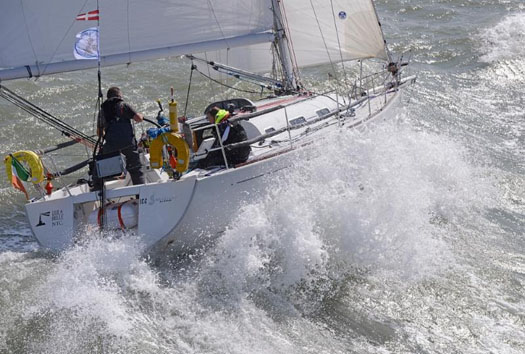
Lula Belle on her way out of the Solent with 1800 miles to race. Photo: Rick Tomlinson
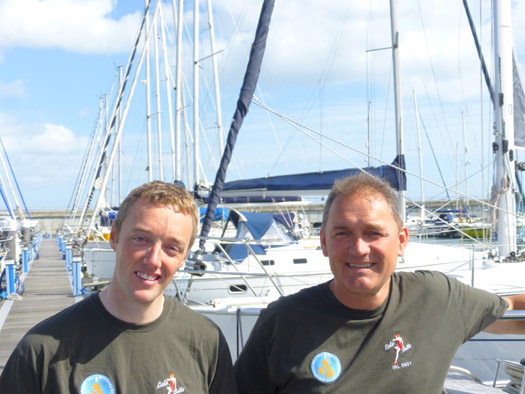
Brian Flahive & Liam Coyne back in Dun Laoghaire on the morning of their return from the finish of the Round Britain & Ireland Race. Photo: W M Nixon
As for the Laser Nats, they were at the end of August and another Ballyholme event, with Johnny Durcan of Royal Cork winning from Rory Fekkes of the home club, while the radials saw Annalise Murphy keep her hand in with a win from Cork's Cian Byrne.
After some rugged August weather, particularly on Ireland's East Coast, September was utterly blissful and it sweetly rounded out Dublin Bay Sailing Club's 130th season, the birthday being marked by a fairly epic dinner in the National YC. September also saw the conclusion of the slowly but steadily reviving Irish Sea Offshore Racing programme, with the end-of-season race from Pwllheli to Dun Laoghaire seeing Liam Shanahan's J/109 Ruth confirmed as the overall winner of the series. Among locally campaigned dinghies, meanwhile, Dun Laoghaire's keen Fireball Class kept its annual programme in lively shape, and the season drew a close with Barry McCartin and Conor Kinsella winning overall from Noel Butler and Stephen Oram.

ISORA Champion Ruth skippered by Liam Shanahan jnr from the National Yacht Club
Across country in Limerick, the CityOne dinghies and the traditional Shannon gandelows created in projects of the Ilen Boatbuilding School made their debut in the city centre on one of the last days of the Indian summer, and then they were put on display in a Naumachia in St Mary's Cathedral which was officially opened by Michael Noonan TD, and later formally visited by President Higgins.
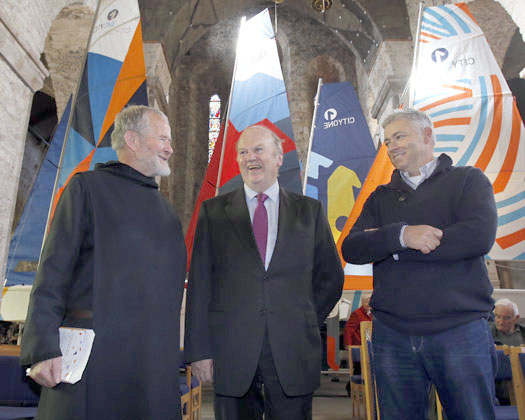
The hopeful new spirit of Irish sailing in 2014 was evident in St Mary's Cathedral in Limerick, when the CityOne dinghies built by volunteers in an inner city revitalisation project went on display in a Naumachia in the Cathedral on September 26th, after their first regatta on the Shannon in the heart of Ireland's City of Culture 2014. With the boats in the cathedral were (left) Brother Anthony Keane of Glenstal Abbey (Director, the Ilen School), Limerick's senior TD and Ireland's Minister for Finance Michael Noonan, and Gary MacMahon (right) Director of the Ilen School & Network for Wooden Boatbuilding. Photo: Press22
And then more vigorous winds returned in October, with the Freshwater Keelboat event on Lough Derg – originally just an exclusive Dragon thing – finding itself swamped with sixty and more boats from five classes and increasingly rugged conditions, such that only the Dragons and Squibs managed to get in any meaningful racing, with Neil Hegarty (RStGYC) winning the Dragons while James Matthews and Rob Jacob of Kinsale topped the Squibs.

Dragons in Autumn action on Lough Derg – Neil Hegarty (right) was overall winner from runner-up Richard Goodbody (left) Photo: Gareth Craig
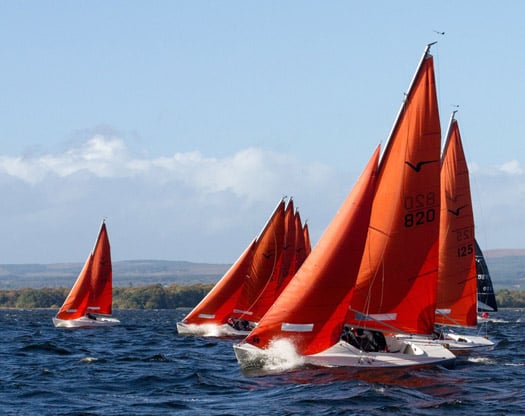
Squibs on Lough Derg – it may look like perfect sailing, but the top came off the weather very soon afterwads. Photo: Gareth Craig
The Student Yachting Worlds in La Rochelle in October had some hiccups in UCD's campaign for Ireland, but while they very narrowly missed the podium in a truly international event, they stayed put at fourth overall. And round in the Mediterranean, a record fleet for the Rolex Middle Sea Race from Malta saw entries soar through the 120 mark for the first time, and the 606 mile race had its first half in light breezes, but the second half was in pure Mistral, with people talking of "winds easing to 44 knots....." A Maltese-owned J/122 won, but second overall and first in her class was the Xp44 XpAct (Josef Schultheis) with a strong Irish emphasis in her crew including Barry Hurley, Andy Boyle, Kenny Rumball and Phillip Connor.
Soon afterwards, the Volvo World Race got under way with first stage from the Med to Cape Town, and Ireland's Justin Slattery on the winning boat on Leg 1. Back home, Autumn leagues had seen renewed enthusiasm as though people had suddenly re-discovered their sport, and the great sailing year of 2014 drew towards its close with the Lasers in Howth starting their 40th winter of annual frostbite racing. This means that HYC have now had a continuous sailing programme since April 1974, while across in Dun Laoghaire the DMYC Frostbite Series must be the most senior of all winter events. Winter Leagues attract more aficionados, with the popularity of the Dublin Bay Turkey Shoot in particular providing a forceful reminder that Dun Laoghaire is the principal sea access for a notably affluent and very large population in South Dublin. With the Turkey on its way, soon it's Christmas. And then the new Irish sailing season will begin on the blue waters of Sydney Harbour.
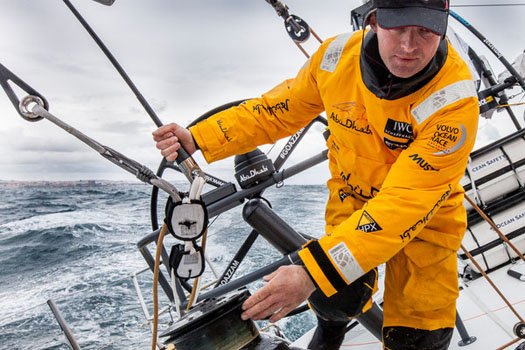
Justin Slattery on Volvo World Race 2014. Photo: Volvo Ocean Race
#srbi – The National Yacht Club and ISORA have announced that Liam Coyne, Co-Skipper of "Lula Belle" will give a talk in the National Yacht Club, Dun Laoghaire on the 12th November at 20.30. All are welcome to attend this unique presentation.
The "Dynamic Duo" of Liam Coyne and Brian Flahive came together for only one race in the season of 2014. They had sailed two-handed together for many years taking an active part in ISORA and also competing in the D2D, Round Ireland and the Fastnet races.
The full story of their campaign featured in WM Nixon's weekly sailing blog on Afloat HERE.
At the end of last season Brian had moved to live in Malta so it was decided that if they were to sail together again they would have to make it "worthwhile". To make it worth the trip from Malta they decided to enter the 1800 mile Sevenstar Round Britain and Ireland Race!!! As the organisers had only just allowed two-handed entries for the first time, they seized the moment and entered.
They could not have picked a worst year to take part in this race. The weather conditions for the start were affected by the remnants of Hurricane Bertha. So bad was the weather that the organisers changed the direction of the race to go anti-clockwise around the course. To avoid the worst of the weather the start was also delayed for 18 hours. 28 boats took part in the race.
Racing Two-Handed around Britain and Ireland requires all round skill, great seamanship and tenacity. Most of the time the Two-Handed pair are alone on deck while the other sleeps. It can be a lonely existence on deck and the lack of sleep and the effects of exposure to the harshest of conditions is bound to take its toll on both yacht and crew.
Lula Belle overcame all the challenges that the course could throw at them. Despite significant breakages and technical problems, they limped over the finish line at 11:40:54 on Saturday 23rd August in an elapsed time of 12 days 02 hours 40 minutes and 54 seconds. They took 5th place overall in the race and 1st in the Two-Handed Class and the combined IRC Three and IRC Four Class.
Liam Coyne will give a talk on his adventure. He will talk about the technical and mental preparation required before and during the race. With the inclusion of video excerpts he will describe the challenges both he and Brian faced and how they dealt with them.
This talk is a great opportunity for any sailor who ever dreamt of racing offshore to learn about the severe challenges Liam and Brian lived through while taking part in what is probably the most challenging offshore race ever.
Liam will give his talk in the National Yacht Club, Dun Laoghaire on the 12th November at 20.30. All are welcome to attend this unique presentation.
Bar food is available in the Club before the talk.
For any enquiries contact Peter Ryan – 087 2545037 or [email protected]
Top Irish Crews Line Out for Malta's Middle Sea Race Tomorrow
#middlesearace – Irish interest in class four of tomorrow's Middle Sea Race in Malta centres on three boats inlcuding last year's winner Otra Vez, a J122 with Ireland's top offshore sailing duo Liam Coyne and Brian Flahive, the August winners of the Round Britain and Ireland race, as part of the hot J-boat crew. Aaron and Edward Gatt Floridia's J122 was the outstanding Maltese entry in last year's race and the first Maltese boat after time correction.
Another top Irish offshore ace Barry Hurley together with dinghy champion,Kenneth Rumball of the Irish National Sailing School, is racing onboard Xpact, an Xp44 in class three.
An Irish team, consisting of three ladies and seven gents, have entered a chartered Dufour 45 under Dublin skipper Cathal Drohan. 'DU4' is in class four for the 600–mile route around Malta and Sicily. Repeat visitor Dermot Cronin's Encore, a First 40.7, is also back for the race in class four.
A Howth Yacht Club team has chartered the Beneteau First 40 'Southern Child', a Bruce Farr-designed cruiser-racer which will race in the IRC 4 class with a rating of 1.083.
HYC team captain Darren Wright and Colm Bermingham will be joined by Howth sailors Kieran Jameson, Frank Dillon, Paul Walsh, Michael & David Wright, Rick De Nieve, Jonny White and Will Murray.
Fellow HYC sailor Laura Dillon will also be competing in the event aboard the Sparkman & Stephens 41 'Winsome'.
This will be the largest fleet ever assembled in the 46 year history of the race. The vast majority of the competing yachts have now registered for the race and about 120 yachts, flying the flags of 24 countries, are set to take on one of the world's most awe-inspiring ocean race courses. Laid end to end, the fleet would form a line of impressive yachts, 1800 metres in length, twice as high as the Burj Khalifa.
Starting and finishing in Malta the 608-mile course around Sicily and its surrounding islands has stunning vistas throughout. The international fleet of yachts will be crewed by an astounding mix of Olympic, America's Cup and round the world sailors, as well as passionate amateur Corinthian sailors. Godwin Zammit. Commodore of the Royal Malta Yacht Club, commented about the success of the Rolex Middle Sea Race.
"The interest in the race has been growing year on year and with entries up over 20% on last year's record entry, the Royal Malta Yacht Club has organised additional berths for competing yachts. In addition to the berths at the Royal Malta Yacht Club, yachts have been accommodated in Grand Harbour and other locations in Malta. Including family and friends of the competing crews, we estimate that well over a thousand people will be visiting Malta for the race. There are many reasons why the race is proving so popular, the Royal Ocean Racing Club has a long association with the race and it is now part of their season's points championship and many of the 18 yachts that have come from Great Britain are doing so for that reason and there is a strong contingent from Italy with 33 yachts visiting from our near neighbour. However, without doubt the most important influence on the success of the race is the prestige and prominence associated with our continued support of Rolex, for which the Royal Malta Yacht Club are extremely grateful."
The hot favourite for Line Honours is Igor Simcic's Maxi, Esimit Europa 2. The European team, led by three-time Olympic Gold medallist Jochen Schumann, will be attempting to take line honours for an unprecedented fourth occasion. Weather permitting, Esimit Europa 2 is capable of beating the course record; 47 hours 55 minutes and 3 seconds. Set by George David's American Maxi, Rambler in 2007.
In IRC 1, there is the mouth-watering prospect of two of the world's best Maxi 72s going head to head. Niklas Zennstrom's Swedish JV72 RAN V and George Sakellaris' American RP72, Shockwave are both crewed by world class professional sailors. Team Ran has won IRC One twice before but Zennstrom's team has never won the race overall. Shockwave will be competing in the race for the first time, George Sakellaris' team was in fine form earlier in the season, winning the RORC Caribbean 600 overall.
In IRC 2 last year's overall winner, Georgio Benussi's TP52, B2 skippered by Michele Galli, returns to defend the title. However, the Italian flyer will first and foremost be focusing on winning a highly competitive class including; Jens Kellinghusen's German Ker 51, Varuna, which won the gruelling Sevenstar Round Britain and Ireland Race and Stefan Jentzsch's brand new hi-tech Carkeek 47, Black Pearl. There are a bevy of yachts in the class which will revel in heavy weather, Vincenzo Onorato's Italian Cookson 50, Mascalzone Latino, German Swan 82, Grey Goose and British Frers 94, Bristolian.
Last year, IRC 3 came to a dramatic conclusion with David Anastasi's J/133, Oiltanking Juno winning the class by under three minutes from Josef Schultheis and Timothy Camilleri's Xp-44, XP-ACT Bank Sails. Both yachts have some of Malta's best sailors on board and will be battling to win again. But IRC 3 is far from a two-horse race. The class of over 25 yachts has strength and depth, including the class winner of the 2014 Cape to Rio Race, Iskareen, co-skippered by Christiane Dittmers and Soenke Bruhns and Class winner of the 2014 RORC Caribbean 600, British Azuree 46 Sleeper, skippered by Jonty Layfield. Rear Commodore of the Royal Malta Yacht Club, Arthur Podesta has competed in every edition of the race and will skipper his First 45 Elusive II BOV.
IRC 4 has over 30 entrants and is arguably the most competitive class. Eric Van Campenhout and Vincent Willemart's MC34, Azawakh has been in outstanding form this year. The Belgian team is currently leading the Royal Ocean Racing Club's Season's Points Championship, in which over 200 yachts have competed, The Rolex Middle Sea Race will be the last race of the series. Azawakh was specially shipped to Malta for the race. GYR Scarlet Oyster is a phenomenally successful yacht, having won class in the Rolex Fastnet Race and RORC Caribbean 600 on numerous occasions. For the Rolex Middle Sea Race, the Oyster 48, GYR Scarlet Oyster will be co-skippered by Ross Applebey and Andy Middleton.
The most successful Maltese yacht of the modern era will be racing in IRC 4. In 2011, Lee Satariano's J/122 Artie, co-skippered by Christian Ripard and with an all-Maltese crew, won the race overall. Artie will be returning to the race course this year with a real chance of winning.
18 yachts will be competing Double Handed, a record for the race. Teams from Croatia, Great Britain, Italy, Malta, Monaco, Netherlands, and Slovenia will take on the gruelling race with just two crew on board. Mikhail Agafontsev's Open 60, Oz is the largest yacht in the Double Handed Class. Alberto de Rossi's Elan 340, Pokekiakkiere, the smallest.
Round Britain & Ireland Sailors Liam Coyne & Brian Flahive Are Sailors of the Month
#rorcsrbi – Liam Coyne of Dun Laoghaire and Brian Flahive of Wicklow are the Afloat.ie "Sailors of the Month" for August 2014, following their stunning and comprehensive success in the 1,802 mile RORC Sevenstar Round Britain & Ireland Race. In it, with the standard First 36.7 Lula Belle, they topped the Two-Handed Division, won two of the RORC classes against opposition which included fully-crewed boats, and finished sixth overall in a fleet in which the results were otherwise dominated by much bigger boats with a large professional element in their crews.
In fact, some of the crews were wholly professional. But the two Irish amateurs not only did the race out of their own time and resources, but they had to be their own shore management and technical support team as well.
In a very gruelling race in which they battled on to success in ferocious conditions which saw them having to cope with a wide range of gear and electronic equipment failure, their sheer enthusiasm and grit was an inspiration to the entire Irish maritime community for the 12 days of the race.
While their challenge was made through the National YC of Dun Laoghaire where Liam (47) is a member, Brian (31) is very much a stalwart of Wicklow SC, where he learned his sailing in the training progammes since childhood. Liam meanwhile didn't start sailing at all until he was 38, and his first club was Poolbeg (to which he retains close links), while the duo also used the ISORA programme extensively to develop their performance. With Brian providing the skill gained in years of sailing, and Liam making a huge input of entrepreneurial flair and unstoppable enthusiasm, the synergy between the two created a formidable challenge which has achieved well-merited international success.
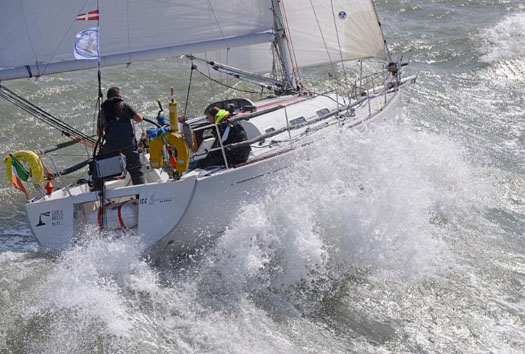
On their way – Lula Belle sails fast eastward out of the Solent at the start of the 1802-mile antic-clockwise circuit of Britain and Ireland. Photo: Rick Tomlinson
Go LulaBelle! How Ireland Won The Round Britain & Ireland Race
#rorcsrbi – For twelve days, Ireland's sailing and maritime community followed with bated breath while the fortunes of Liam Coyne and Brian Flahive with the First 36.7 Lula Belle waxed and waned in the storm-tossed 1802-mile RORC Sevenstar Round Britain & Ireland Race. Last Saturday, they triumphed, winning the two-handed division and two RORC classes in this exceptionally gruelling marathon. W M Nixon delves into the human story behind the headlines of success.
It used to be said that Irish seamanship was the skilled and stylish extrication of the vessel from an adverse and potentially disastrous situation in which she and her crew shouldn't have been next nor near in the first place.
While we may have moved on a bit from that state of affairs with a less devil-may-care approach to seafaring, there's no escaping the fact that this morning we can now look back at two remarkable Irish victories in topline international offshore events in recent years in which both crews overcame major setbacks and situations, rising above very adverse circumstances which could well have deterred sailors from other cultures where the philosophy is not underpinned by the attitude: "Ah sure lads, things aren't good. Not good at all. But let's just give it a lash and see how we go".
It was seven years ago when a full entry list of 300-plus boats was slugging westward down the English Channel in the first stages of the Rolex Fastnet Race 2007. Already, the start had been postponed 24 hours to allow one severe gale to go through. But in an event still dominated by the spectre of the 15 fatalities in the storm-battered 1979 race, most crews were hyper-nervous about another gale prospect, and by the time the bulk of the fleet was in the western English Channel, many succumbed to the allure of handy ports to lee such as Plymouth, and in those early days of the race something like 48% of the fleet retired.
But aboard Ger O'Rourke's Cookson 50 Chieftain out of Kilrush on the Shannon Estuary, they were well into their stride. That year, the boat had already completed the New York to Hamburg Transatlantic Race, placing second overall. But owing to her Limerick owner's quirk of never confirming the boat's entry for the next major event until the current one is finished, they found themelves only on the waiting list for that year's already well-filled Fastnet Race entry quota.
Chieftain was 46th on that list. Yet while those who had made an early entry fell by the wayside, steadily this last-minute Irish star rose up the rankings. With three days to go, Chieftain got the nod. They went at the racing after the delayed start as though this had been a specific campaign planned and carefully executed over many months with a full crew panel, instead of a last-minute rush where crew numbers were made up by a couple of pier-head jumpers who proved worth their weight in gold.
Yet then, as the new strong winds descended on the fleet as the group in which Chieftain was already doing mighty well was approaching the Lizard Point, the troubles started, with gear failing and boats pulling out left and right. But the Irish boat was only getting into her stride. A canting-keeler, she could be set up to power to windward in a style unmatched by bigger craft around her. Approaching the point itself in poor visibility to shape up for the fast passage out to the Fastnet Rock with even faster sailing, things looked good. And then the entire electronics system aboard went down, and stayed down.
Here they were, not even a third of the way into a race which promised to be rough and tough the whole way, but a race in which they would at least have been expecting know their speed, performance and position down to the most minute detail. Instead, they were in an instant reduced to relying on a couple of tiny very basic hand-held GPS sets, and paper charts.
Ger O'Rourke's Chieftain sweeps in to the finish at Plymouth to win the 2007 Rolex Fastnet Race overall
Those paper charts were little better than pulp by the end of a very wet race in an inevitably extremely wet but searingly fast boat. But they did get to the end, and with style too. They won overall and by a handsome margin. It was the first-ever Irish total victory in the Grand National of Ocean Racing. The owner-skipper had to go up the town to buy himself a clean shirt for the prize-giving in the Plymouth Guildhall.
Yet when Ger O'Rourke's Chieftain swept into Plymouth and that triumph just over seven years ago, the boat was in much better racing shape than Liam Coyne's First 36.7 Lula Belle when he and Brian Flahive completed the final few miles back into Cowes around midday last Saturday to finish the 1802-mile Sevenstar Round Britain & Ireland Race.
Lula Belle had many gear and equipment problems after an extreme event where the natural pre-start nervousness had been heightened by a reversal by the Race Management of the originally clockwise course as the 10th August start day approached. It would have been folly to send the fleet westward into storm force westerlies in restricted waters. Eastward was the only sensible way to go.
Then the arrival of the remains of Hurricane Bertha – which seemed to be finding new vigour – led to new tensions with the start being postponed from midday Sunday to 0900 Monday. It was disastrous from a general publicity point of view. But it would have been irresponsible to send a fleet of boats – some of them mega-fast big multihulls – hurtling towards the ship-crowded narrows of the Dover Straits beyond the limits of control in a Force 11-plus from astern.
Even when they did race away, it was with a Force 8 plus from the west, with the Irish crew recording 42.5 knots of wind aboard Lula Belle (and from astern at that), before they lost all their instruments from the masthead on the first night out. For a double-handed crew, that was a very major blow. Two-handers are allowed to use their auto-pilot, and if all the wind indicators are functioning in proper co-ordination with it, then the boat can sail herself along a specific setting on the wind. It's as good having at least one extra hand – and a skilled and tireless helmsman at that - on board.

Lula Belle on her way out of the Solent with 1800 miles to race and everything still intact. Photo: Rick Tomlinson
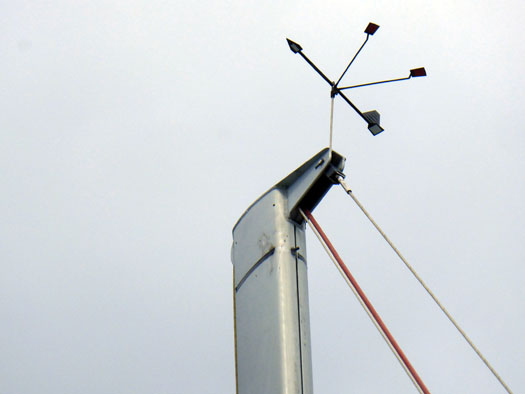
There it was – gone. After the first night at sea, Lula Belle's masthead was bereft of everything except an often defective Windex. Photo: W M Nixon
Fortunately the auto-pilot itself was still working on its own, and they became well experienced in setting the boat on course and then trimming the sails to it in a continuous process which worked well except when the seas were so rough and irregular that they had to hand steer in any case, albeit with the apparent wind indicated only by the sole survivor of the masthead units, the little standard Windex. But it must have been damaged when everything else was swept away, as from time to time it jammed. When that happened, the only wind indicators available to the two men were the Sevenstars battleflag on the backstay, the tell-tales on the sails, or a moistened finger held aloft, as neither were smokers.
Despite this, they made their way north through the North Sea and all round Scotland and its outlying islands and right down the western seaboard of Ireland as far as the Blaskets before things went even more pear-shaped. In fact, the wheels came off.
Their ship's batteries had been showing increasing reluctance to hold power, essential for the continuing use of the autohelm and the most basic need for lighting and any still-usable electronic equipment including the chart plotter. But thanks to a trusty engine battery, they could start the motor to bring the ship's batteries back up to short-lived strength. Yet while approaching the Blaskets, the engine refused to start, and nothing they could do would coax it back to life. Inevitably they lost power, and for the final 495 miles of the race – the equivalent of 78% of a Fastnet Race - the boat was sailed and navigated entirely manually, with the required navigation lights provided by modified helmet lamps.

The chart plotter shows only too clearly where power was lost completely just north of the Blaskets. Photo: W M Nixon
Yet they finished well last Saturday, around noon on August 23rd after twelve days racing. They won the two-handed division overall, they won Classes IV & V, and they placed sixth overall in a combined fleet in which big boats with a strong element of professional crewing dominated. So who are Liam Coyne and Brian Flahive, and what about Lula Belle, the heroine of the tale?
Afloat.ie caught up with them on Thursday morning in Dun Laoghaire marina, where they'd got home an hour or so before dawn to grab a quick sleep of a few precious hours before awakening to more sunshine than they'd experienced for a long time, as the Round Britain & Ireland was raced across an astonishingly sunless sea. As for the 450-mile passage home to Dublin Bay, it had been achieved through mostly miserable weather and an enforced and brief stop in Plymouth to try to get a final solution to the continuing electric problems, which had defeated the finest minds in Cowes.
But such hassle fades when the return home is completed, and the Lula Belle crew were in great form. They complement each other. Brian Flahive is from Wicklow and he's a studious, thoughtful type. He turned 31 just three days after the win, making it his best birthday ever, and a fitting highlight in a sailing CV which continues to develop, and began with local sailing and training courses with Wicklow Sailing Club after his sister Carol had acquired a Mirror dinghy.
Since then, Carol's seagoing has taken a slightly unexpected turn as she found her vocation in the lifeboat service, and that is now her main interest afloat - she is a helm on the Wicklow lifeboat. But her younger brother Brian was soon hooked on pure sailing, and from the Mirror he soon went on the 420s where his enthusiasm was noted by local keelboat owners, who in turn recruited him aboard, and soon he was noted by those assembling offshore racing crews too.
When you've talent, enthusiasm and time available, the word soon gets about in the limited recruiting pool available to Ireland's offshore racing folk. Soon, young Flahive was spreading his wings with his home port's biennial Round Ireland race, and participation in Irish Sea Offshore Racing. He proved adept at and interested in two-handed sailing in particular, and soon got to know another relative newcomer to the Irish Sea offshore racing scene, Liam Coyne.
Liam Coyne is 47, and something of a force of nature. There's a mischievous twinkle to his eye, but there's a very serious side to him too, even if – as when he admits he's extremely competitive – it's done in the best of humour. He's from Swinford in County Mayo, where any knowledge of boating might relate to the big lake of Lough Conn nearby. But as he left Mayo for the USA just as he was turning 20, his passionate sailing involvement has been entirely generated during his more recent life in Dublin.
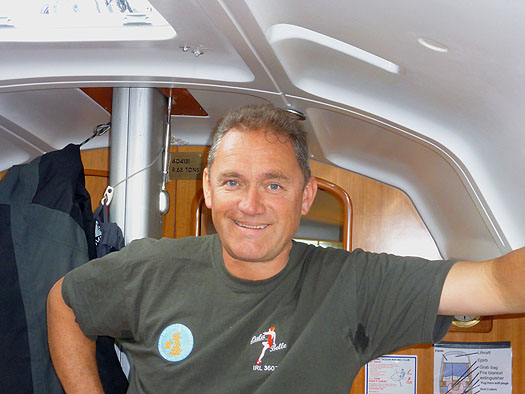
There's a mischievous twinkle, but Liam Coyne makes no secret of his competitive nature. Photo: W M Nixon
Back in the 1980s, well before Australia took off as the destination of choice for energetic and ambitious young Irish people, America was still the Land of Dreams. Coyne's teacher of English in Mayo was so sure of this that one of his courses was built entirely around the USA's immigration examination. He did a good job, young Coyne made the break, and he started to fulfill his ambition of getting to all the American states by spending time – sometimes quite a lot of it – in 26 of the States of the Union. Eventually with a winter approaching, he found the building site he was quietly working on in Boston was due to close completely for the colder months. But he managed to swing a job selling Firestone tyres (sorry, "tires") from the local agent's shops. It was a union created in heaven. Liam Coyne and tyres – the bigger the better – were made for each other.
He prospered in the tyre business in Boston and enjoyed his work, but there was always the call of home and a girl from Swinford who had qualified as a teacher. So he came back to Ireland in 1998, set up in the tyre business in Leinster, married the girl and settled down in south Dublin to raise a family.
Came the boom years, and the tyre business prospered mightily. Liam Coyne Tyres had five depots and employed 48 people. He was mighty busy, but seeking relaxation. So on the October Bank Holiday Monday in 2005, he and his wife went to the Used Boat Show at Malahide Marina and by the time they left, Alan Corr of BJ Marine had sold them a handy little Beneteau First 211, their first boat.
His knowledge of boats and sailing was rudimentary to non-existent. His maiden voyage, the short hop of 12 miles from Malahide to his recently-joined new base at Poolbeg Y& BC in Dublin port, took all of 14 hours as the tyro skipper battled with the peculiarities of tide and headwinds, happily ignoring the potential of the little outboard engine on the transom even though, as Alan Corr cheerfully told him later, it could have pushed the boat all the way to Arklow in half the time.
But he was enchanted by this strange new world, and the camaraderie of the sailing community as expressed in Poolbeg. He made a tentative foray into the club's Wednesday night racing, and was even more strongly hooked. But even though those Wednesday club races in the inner reaches of Dublin Bay were such fun that from time to time he still returns to race with his old clubmates at Poolbeg, he knew that his ambitions would dictate a move into a larger boat, and the bigger world of Dublin Bay sailing. So when the next Dublin Boat Show came along, he went to it and ended up buying a Bavaria 30 from Paddy Boyd, who was marketing Bavarias in the interval between being Secretary General of the Irish Sailing Association, and Executive Director of Sail Canada.
Paddy Boyd wised him up to the Dun Laoghaire sailing scene, and which club he might find the most congenial while being suited to his ambitions. For Liam Coyne was discovering offshore racing, and particularly the annual programme of the Irish Sea Offshore Racing Association. He liked everything about ISORA, the friendships, the willingness to help and encourage newcomers, and the pleasant sense of a mildly international flavour between the English, Welsh and Irish contingents.
One of his fondest memories is of taking his Bavaria 30 across to North Wales for the annual Pwllheli-Howth race which traditionally rounds out the season, and is often blessed with Indian summer weather. As he headed away from Dublin Bay, he suddenly realised it was the first time he had ever left Ireland under his own command. All previous exits had been on scheduled ships or planes. It was a very special moment.
Yet while he treasures the memory of such special moments, it wouldn't be Liam Coyne if he wasn't moving on. He'd relocated his base of operations to the bigger scene of the National Yacht Club and Dun Laoghaire, and developed his taste for double-handed offshore racing and its link to a group whose only common denominator seemed to be that many of them shared an enthusiasm for racing vintage Fireballs in Dun Laoghaire harbour in the winter.
But in the summer, keelboat offshore racing with just two on board was increasingly their main line, and he was soon on terms of friendship with the likes of Brian Flahive, Barry Hurley and others, while the double-handed class in events like the Dun Laoghaire-Dingle, the Round Ireland, and the Fastnet itself were coming up on the radar.

The newly-acquired First 36.7 which became Lula Belle greatly broadened the scope of Liam Coyne's offshore racing. Photo: W M Nixon
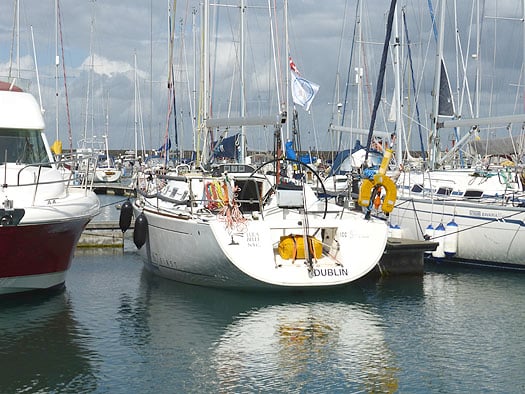
The First 36.7 is of a useful size to be a very pleasant family cruiser, but Lula Belle has been a multi-purpose boat since Liam Coyne bought her, with the emphasis on double-handed offshore racing, and the longer the course, the better. Photo: W M Nixon
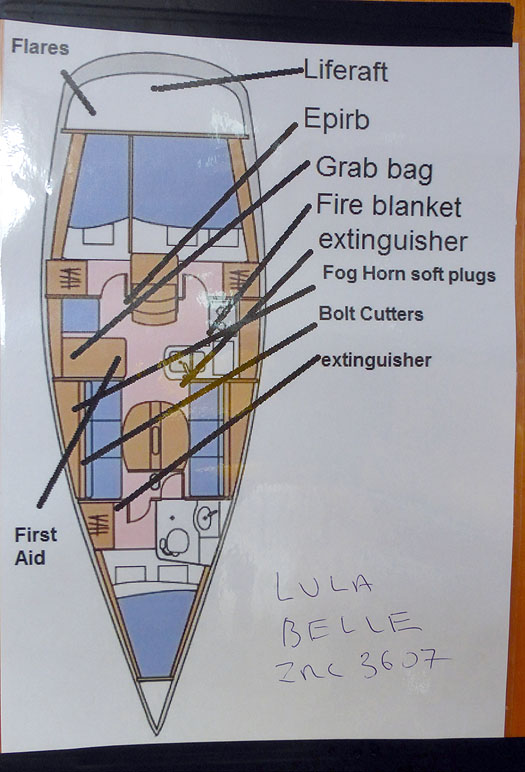
Lula Belle's layout - the accommodation of a cruiser/racer with extras installed for serious offshore racing, but for proper cruising they'd also be required. Photo: W M Nixon
Having made his mark offshore partnered with Brian Flahive on the Bavaria, he very quickly moved up to the almost-new First 36.7 Baily, bought from Tom Fitzpatrick of Howth. His name of Lula Belle for the boat was inspired by a recently-deceased aunt who had invariably addressed all of his sisters as "Lula Belle" when requesting something like a cup of tea. It's certainly a distinctive name, and it was beginning to feature regularly in short-handed and fully-crewed offshore racing reports when Ireland fell off the economic cliff around 2007.
The tyre business was hit particularly hard, for they're items whose replacement people can try to avoid by shifting used tyres around on and between vehicles to get the last piece of tread usable. But fortunately, one of his key contracts was in the heavy industrial area, where they use tyres so big your everyday motorist has no notion of them, yet legal safety working requirements dictate their regular replacement.
Despite this, at one stage his fine workforce of 48 had become effectively just two, while three of the five depots were closed. "I can tell you" he says, "there were times when we were glad enough the wife had kept her teaching job". And they were raising a family, eventually with three kids with a much-loved holiday home at Enniscrone in southwest Sligo. Then too he had this 36ft racing boat too. Yet all his fine assets and the value of the family home in Dublin had effectively been slashed by at least 50% and often more.
But somehow he kept going, and he even continued to race offshore. By this time one of the leading figures in the Irish short-handed sailing scene, Barry Hurley, had moved to Malta, and when he was recruiting crew for a friend with a Grand Soleil 40 for the annual 620-miles Middle Sea Race from Valetta in late October, he filled four berths with able-bodied crew from Dublin including Barry Flahive and Liam Coyne.
That race brought something of another epiphany to match that moment of pure joy at realizing he was skippering his own boat out of Irish waters for the first time. They'd come through the Straits of Messina eastward of Sicily, and next turn of the course was the volcanic island of Stromboli. It was a blissfully warm summer's night, and Liam was at the helm in just shorts and shirt, enjoying the sail and revelling in the race.
Stormboli was gently erupting just enough to show it was there, and ideal to be a mark of the course. "I'll tell you," says Liam, "it was a very long way indeed from your usual October night in Swinford". The magic of the moment reinforced his ambition to see his business through the recession and out the other side, which he has now achieved with busy depots in Navan and Dublin, and staff back above the twenty mark. Yet oddly enough, it also reinforced a shared ambition with Brian Flahive to do the four-yearly Seven Stars Round Britain & Ireland Race, when conditions up in the northern seas off Shetland and across towards the Faroes can often make an October night in Swinford seem like the balmy Mediterranean by comparison.
But the idea just wouldn't go away, and they put down their names for the 2014 race. With the economy coming out of intensive care and two good managers running his two depots and the three kids though the very young stage, Liam Coyne felt he could take off the time for this major challenge. But even so it was done without any form of shore management support, and in fact he managed to mix it with some family cruising – to which the boat is surprisingly well suited – by taking his young son Billy (10) and daughter Katie (8) along with him for a leisurely delivery to Cowes by way of many of the choice and picturesque ports along the south coast of England, where his wife and the youngest child joined the party to see them off.
That was in the last of the summer. By the time the starting date was upon them, it was as if a giant and malevolent switch had been activated. The weather was horrible, and even when Bertha had finally grumbled along on her way, it was anticipated that the rush of bitterly cold north winds she'd drag down from the Arctic in her wake would be every bit as unpleasant.
Then came the complete reversal of the course, and the postponement of the start. For a crew who were being their own shore managers and technical support team, it added a last minute mountain of research work on the shape the weather might be when they finally got away, and all the mental strains of waiting overnight for the start. As the lowest-rated boat in the entire fleet, they may have had the consolation of knowing that if they finished with just one boat behind them then they wouldn't be last on corrected time. But by being the low-rater, they would probably finish so long after everyone else that any general celebration would be long over.
That said, when a double-handed team have already successfully bonded, they're better at withstanding the strain of an enforced wait for a delayed start than a larger crew. I can remember only too well when the RORC Cowes to Cork race of 1974 was postponed for ten hours by the then RORC Secretary Mary Pera. A Force 10 sou'wester was making the Needles Channel a complete maelstrom on the spring ebb, but it was forecast soon to ease, so we were to be sent off on the evening ebb.
To get through the wait, it seemed best to stay well away from the boat and have a quiet day if at all possible. But aboard the 47-footer on which I was sailing, there were action men who decided it was time for a party lunch. So although I slunk away alone up the back streets of Cowes (Kensington-on-Sea it was not), and found a little café where the owners were persuaded to provide lunch of boiled potatoes and steamed fish instead of the usual nausea-inducing fish'n'chips, back on the waterfront others meanwhile had different ideas. A massive former rugby international in our crew decided the best way to pass the time was a champagne reception in one of the Cowes clubs followed by a bibulous lunch, and he persuaded several shipmates to join him, though they were circumspect in their consumption while he went at it as though it would be the last festive lunch in his life.
When we finally got racing the wind had indeed eased, though things were still rough enough in the Needles Channel, where we slammed into a head sea with such vigour that the Brookes & Gatehouse speedo impellor – normally a particularly stiff-to-move bit of equipment – was shot into its hull housing so totally we assumed it had broken entirely. It took a few seconds to realize what had happened, and it worked again happily enough once it had been pushed back into working position with the usual robust heave.
However, our mighty rugby forward was not so happy. He was not a happy budgie at all. The news is that, though you may be battering along noisily but successfully with endless bangs and squeaks and groans of one sort or another, when an international rugby forward of classic size gets massively seasick, a new dimension enters the sound and vibration scene - it's as if the entire boat is shuddering from end to end.
But enough of that. In Cowes on the morning of Monday August 11th 2014, it was still blowing old boots from the west , but they tore away downwind like there was no tomorrow. And for some, as far as racing was concerned, there wasn't. Any tomorrow, that is. There were several overnight retrials that set out to be temporary but became permanent. Aboard Lula Belle, however, they were still going strong, but after recording that gust from astern of 42.5 knots (which meant it was pushing 50), the masthead broccoli decided it had had enough, and made its exit.
Some time long before the race, Liam had decided he'd ensure the minimum use of power by having a LED tricolour masthead light, and a technician had been sent aloft to fit it. But that first night, it took off on its own, but taking much else with it, and leaving a beautifully clean masthead, but damn all information for those down below other than a Windex with an increasing tendency to jam.
And already the sails were suffering, for although their gybes were hectic enough, they didn't have to worry about check-stays or runners. But the downside of that was the well-raked spreaders, which helped support the mast in the absence of any aft support rigging other than the standing backstay. The inevitably prominent upper spreader-ends were chafing holes in the mainsail which, despite repairs, were enormous by the finish.
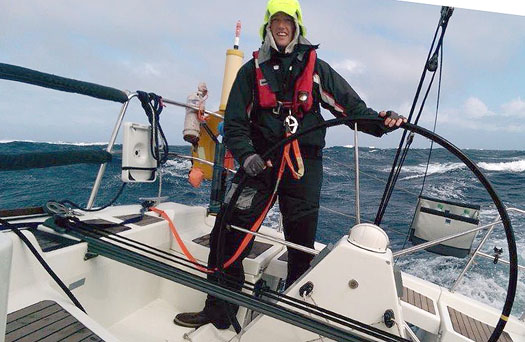
Speed at sea – Brian Flahive on the wheel as Lula Belle puts in the kind of sailing which knocked off 200 miles a day. Photo: Liam Coyne
But they blasted on, roaring on a reach up through the North Sea with Lula Belle doing mighty well, as the more extreme boats such as their closest rival, the Figaro II Rare, weren't quite getting the conditions to enable them to fly, whereas old Lula Belle was knocking off 200 miles in every 24 and saving her time very nicely.
North of the English/Scottish border, the strong winds drew ahead. The forecast, however, was for westerlies, so some boats in front laid markedly to the westward looking for them. But Coyne and Flahive sailed a canny race. What they knew of the weather maps suggested very slow-moving and messy weather systems with lots of wind. And from ahead. They reckoned the prospect of westerlies was just too good to be true. And they were right. On the entire leg up to Muckle Flugga, the most northerly turn, they never strayed more than five or six miles from the rhumb line, and thus they sailed the absolute minimum distance, albeit in very anti-social conditions, to get to the big turn.
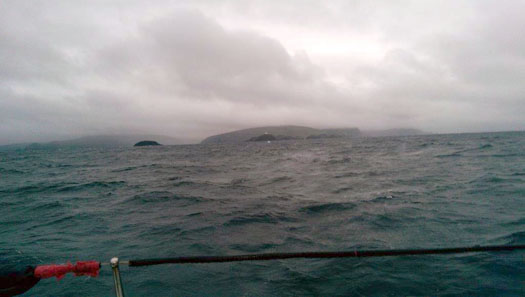
The sunless sea, with Lula Belle getting past Muckle Flugga on Shetland, the northerly turning point of the RB & I Race, and the sky promising plenty of wind Photo: Liam Coyne
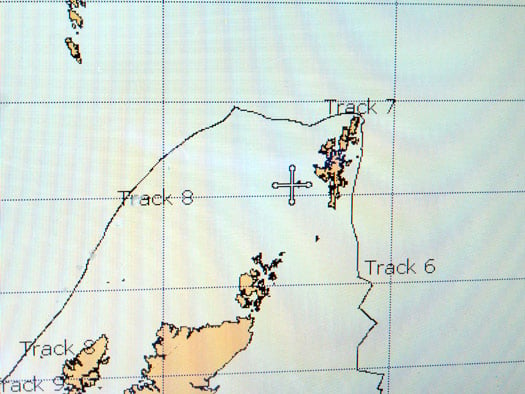
The win move. Although Lula Belle had taken a conservative route northward, once they'd rounded Muckle Flugga they took a flyer to try to get on the favoured side of a slow-moving yet very intense low. The plan succeeded, but they'd to go almost halfway to the Faroes for it to work. Photo: W M Nixon
By this time the faster boats had got back into a substantial lead, but here the situation suited the Irish duo. Those in front went battering and tacking into a fierce sou'wester, trying to get nearer the next turn at St Kilda. But the Irish boat's cunning scheme was to slug directly westward once they'd rounded Muckle Flugga, and not tack until they'd some real prospect of being in the harsh northerlies which they knew to be somewhere out beyond the very slow-moving low pressure area.
Thus they ended up midway between the Shetlands and Orkney to the southeast, and the Faroes to the northwest. As Liam Coyne drily puts it: "When you take a flyer like this and it works, it isn't a flyer any more – on the contrary, it's the only way". What they didn't know was that the boats trying to batter their way past the Outer Hebrides and down towards St Kilda had taken such a pasting that their immediate rival Rare had made a pit stop to rest up in the Shetlands, and others dropped out "for a while" only to find it had become a matter of retiring from the race.
But Lula Belle, having cast the dice to go west, had no option but to keep going, as she was nearly 50 miles west of the Rhumb Line, and more a day's fast sailing from any shelter. By this time, the Scottish forecasters had up-graded their gale warnings to severe storm Force 10. But thanks to their pluck in going west, Coyne and Flahive were up towards the northwest corner of the low, whereas the opposition were down in the southeast quadrant where the winds are usually significantly stronger.
Nevertheless at the change of the watch they shortened sail to the three-reefed main and the storm jib, even though the wind had fallen right away. Brian went off watch and then returned on deck after some sleep to find Liam had become becalmed, and had been so for some time. The centre of the low was passing straight over them. Now it was only a matter of time before the new wind came out of the north.
When it did it was nasty and cold, and the sea became diabolically rough and confused. But it was a fair wind, and they made on as best they could through the short northern night to close in on St Kilda. It was sunrise when they went past that lonely sentinel, and for once there was briefly sunshine to prove it, but it was watery bad weather sunshine as they settled in for the long haul to Ireland.
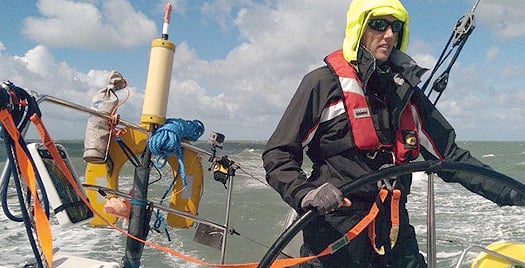
A great fair wind at last, but it was so very very cold despite some sunshine. Photo: Liam Coyne

Early morning as they pass St Kilda, with Lula Belle well placed in the race and her closest but higher-rated rivals astern. Photo: Iiam Coyne
By this stage the boat was very much their home, and they were both in good spirits. Despite the expectation of being in race mode for at least ten days and probably much more, they hadn't anything too much in the way of special easy-made instant food. When asked who had organized their stores and how they had been procured, Liam responded: "I just went to Tesco before the race, and filled her up. It's very easy when you've only two. I've had to do the stores for the boat with a crew of eight, and it's a pain in the neck".

Getting an omelette just right is tricky at the best of times, yet this masterpiece was created aboard Lula Belle off the coast of Donegal in 30 knots of wind. Photo: Liam Coyne
As for living aboard, they used the two aft cabins for sleeping, with hot bunking dictated by which was the weather side. In cruising mode, the First 36.7 is a very comfortable boat, but in racing things tend to get put behind the lee-cloth on the weather settee berth in the saloon, for the fact is the boat is designed to be raced with a crew of 7 or 8, and she tends to be a bit tender without six bodies on the weather rail.

Post-return temporary disorder in Lula Belle's saloon on her arrival back in Dun Laoghaire after sailing nearly 3000 miles in all since she'd last been in her home port. Though Brian (left) and Liam used the aft cabins for the short off-watch periods of sleep, the lee cloths on the settee berths were kept up to provide ready stowage for loose gear, preferably on the weather side. Photo: W M Nixon

Having the toilet on the fore-and-aft axis is very convenient at sea. And having an "extra-easy-cleaned" compartment is a real boon for hygienc. As for the funnel and hose, that's essential in a men-only boat in racing mode. Photo: W M Nixon
To my mind, one of the best things about the accommodation is the heads (toilet if you prefer). Some folk might think the compartment is too compact, but the loo is aligned fore and aft, so there simply isn't the room to fall about when using it. With the fore and aft alignment, security and comfort is guaranteed at those special private moments. It should be a law of yacht design that any boat which is going to be taken further than half a mile offshore is designed with a fore and aft loo.
Such thoughts would not have been forefront in the minds of Lula Belle's crew as they set the A3 spinnaker for the long run to Black Rock off the Mayo coast. Inexplicably, and as evidence of their stretched shoreside management support arrangements, they'd failed to bring along a new Code Zero spinnaker from sailmaker Des McWilliam. They'd gone for it despite it putting three extra notches on their rating, but it was nowhere to be found. After the race, it was discovered among a pile of 20 sails in Liam's Dublin office. But out in the lonely ocean southwest of St Kilda, it wasn't there when it was needed.
Yet it was soon needed even more. The smaller sail that was put up simply disintegrated after a brief period of use. It was inexplicable, but reasons weren't important just then, they were now down to just two spinnakers, and a very long way to go downwind to the finish.
So they nervously got out the A4, and soon it was up and drawing and Lula Belle was back in business, sailing fast for Ireland. Liam went below for a much-needed kip, and a sudden squall over-powered the boat. By the time he got back on deck she'd broached completely and the sail was shredded. They were down to just one spinnaker, and one in very dodgy condition at that. To add to their joys, in a crash gybe the mainsheet carriage disintegrated and they'd "ball bearings, it seemed like hundreds of them, all over the place...."
So there they'd been, passing St Kilda and knowing that, despite the lack of sailing instruments, they couldn't have done the leg from Shetland any better, and more importantly knowing from Yellowbrick that Rare was now well astern. Yet here they were now, only a few hours on the way, and they were down to one spinnaker and a jury-rigged mainsheet arrangement and a long way to go and the weather starting to suit Rare. Could it get any worse?
It did. Approaching the Blaskets, as usual the ship's batteries were draining with unreasonable speed. But the engine, when called upon, was dead. Dead as a dodo. It turned over but just wouldn't start. They knew that in very short order they'd be even further cut off from the outside world than they were already, with no chart plotter and without even the comfort of Yellowbrick to tell them how they stood in relation to the opposition. No autohelm whatever, either. And they'd 495 miles still to sail.
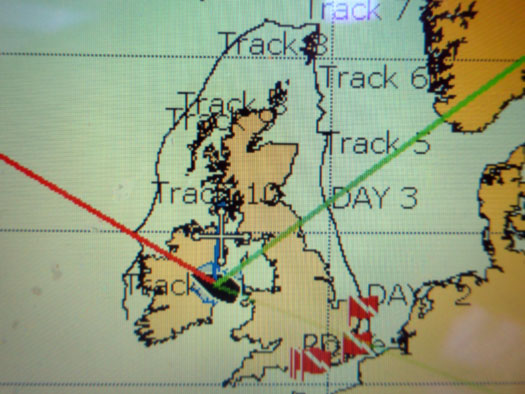
Moment of truth. The chart plotter's power dies just north of the Blaskets, the most westerly point of the 1802-mile course. Photo: W M Nixon

Getting on with it. Just south of the Blaskets, Brian goes aloft to try and clear the constantly-jamming Windex. Photo: W M Nixon
So they picked themeselves up, dusted themselves off, and started all over again. Brian went aloft to the waving masthead to free the Windex, which was in its jamming mood. Then progress was good heading down towards the Isle of Scilly. But even so, midway across, alone at the helm and steering and steering and steering, Liam admits to a very low moment.
They were now almost midway between Cowes and Dun Laoghaire, So he thought to himself: Why not just turn to port and head for home? Head for that comfortable NG34 berth in Dun Laoghaire marina, instead of struggling on with sails which were bound to shred even further, and leave them eventually straggling across the line completely dog last and with everything to fix, and then they'd have to turn round and plug into the early Autumn gales all the way back round Land's End to Dun Laoghaire?
And what then? he thought. Well, then in four years times we'll have to do the damned thing all over again. All, all, over again. So we'll just finish the bloody thing now, and get the T-Shirt, and that will be that regardless of how far we're placed behind everyone else, and good riddance to it all.
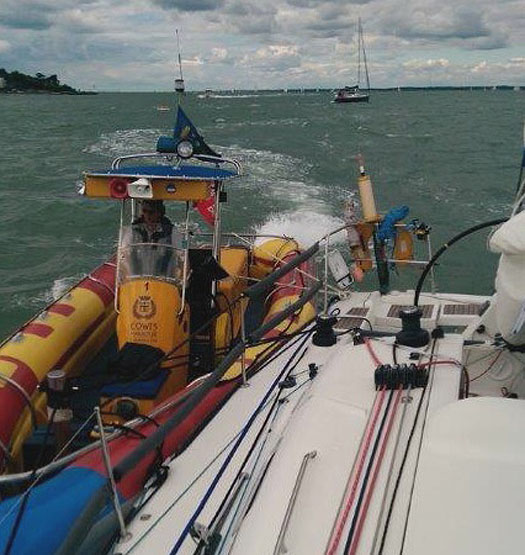
Welcome back. Knowing of Lula Belle's engine-less plight, the Cowes harbourmaster made sure they were brought into their Berth of Honour in style. Photo: Liam Coyne
So they stuck at it, they nursed the boat through the shipping separation zones at the Scillies without the spinnaker up because they knew the multiple gybing would destroy it, then as Rare didn't get past them until this stage, they knew that after such a long race she'd need to be 22 hours ahead at the finish and that was surely impossible. They were very much in with a shout of being better than last, so they nursed that mangled old spinnaker right up the English Channel (Mother Flahive's emergency sewing machine had done some marvellous repairs), and maybe the spreader ends were now showing out through the mainsail again, but what the hell, they got in round St Catherine's point and shaped their way back into the eastern Solent and on up to Cowes, and didn't Rare's crew and various bigwigs come out to tow them into port and confirm to them that they had indeed been there, they'd seen it, they'd done it, they'd won it., and now they could get the T-shirt.

Been there, seen it, done it, won it, got the T-shirt.....Liam Coyne back at the bar of the National YC five days after winning the two-handed division and two RORC classes in the 1802-mile Seven Stars Round Britain & Ireland Race 2014, and with his boat Lula Belle safely returned to her home port of Dun Laoghaire. Photo: W M Nixon
Irish Duo Win First Ever Two Handed Round Britain & Ireland Race
#rorcsrbi – Before the 2014 Sevenstar Round Britain and Ireland Race, a two-handed team had never completed the 1800-mile course. However three teams from Ireland, Britain and Germany have now accomplished that magnificent achievement. Racing Two Handed around Britain and Ireland requires all-round skill, great seamanship and tenacity. Most of the time, the Two Handed pair are alone on deck. Whilst a team mate sleeps, it can be a lonely existence on deck and the lack of sleep and the effects of exposure to the harshest of conditions is bound to take its toll on both yacht and sailor.
Liam Coyne's First 36.7, Lula Belle with Brian Flahive as crew, finished the Sevenstar Round Britain and Ireland Race at 11:40:54 on Saturday 23 August in an elapsed time of 12 days 02 hours 40 minutes 54 seconds. The duo won the Two Handed Class and the combined IRC 3 and IRC 4 Class. Listen to Afloat's finish line podcasts and Liam's thoughts on the finishing here.
Five days ago, the Irish First 36.7, Lula Belle with Liam Coyne and Brian Flahive racing Two Handed was off Dingle on the West Coast of Ireland. Liam reported that they had lost the use of their engine. With 500 miles still to go, Lula Belle had no means of generating electricity and were considering retiring from the race. The team had shredded two of three spinnakers and damaged their mainsail, but they never gave up:
"We had serious doubts that we could finish this race," admitted Liam dockside. "When the engine went, we didn't think there was much more that could go wrong, but at the end of the day, this race is an endurance test for yourself and the boat; that is what it is all about. Brian and myself have done two Fastnets and two Round Irelands but there is no comparison. This race is the hardest we have ever done. We took a hammering for a couple of days but you are 12 days at it, battling for two hours at the wheel, taking two hours rest and then you're back at it again. To rest when you are off watch, you have to put complete trust in one another and myself and Brian have 100% confidence in each other."
Lula Belle, Irish Two-Handed team, Liam Coyne and Brian Flahive spray their celebratory champagne - Patrick Eden/RORC
Brian Flahive, first mate on Lula Belle was delighted to hear that fellow Irishman, Damian Foxall - outright record breaker on MOD 70, Musandam-Oman Sail - had commented on Lula Belle's efforts: "Fair play to Liam and Brian - that's hard core and their efforts show the true spirit of two handed racing. Liam and Brian have normal jobs but their achievement is just as great as the professionals and in many respects, the sacrifices they have had to make puts their achievement even higher. I wish them huge congratulations on finishing the race and their magnificent result."
"Damian Foxall is a big idol to us, someone we look up to and it is really nice to get that compliment from him. There were more than a few memorable moments in this race, but when the engine was gone, we lost everything, even our windex was jammed. The only way to tell the wind direction and speed was the Sevenstar battle flag on the backstay! However we said to each other people have gone a lot further with nothing, so we kept going. We made up some nav-lights with a head torch and a lens over it and two torches taped onto the transom and a head torch each and that was it. We were cautious around the Scilly Isles because we had no electronic navigation, just the chart and a compass. Liam and myself would like to thank the Harbour Master at Cowes for giving us a hand to get to the mooring after we finished and also to Rare, for cheering us over the finish line. Right now, we have a long jobs list, but top of it is definitely to eat a good steak and chips."
Ian Hoddle's British Figaro II, Rare with crew Conrad Manning completed the Sevenstar Round Britain and Ireland Race just after 0900 BST on Saturday 23 August 2014, taking Line Honours for the Two Handed Class after almost exactly 12 days at sea (elapsed time: 12 days 0 hours 18 minutes 09 seconds). No Two Handed team has ever completed the race before and with a water-line length of just 32 feet, Rare is also the smallest yacht to ever complete the race.
Ian Hoddle has been raising money for CLIC Sargent all season. The charity has been providing care for his five year old nephew James, who was diagnosed with an inoperable brain tumour last January. The plight of his young nephew, bravely fighting the disease, has been a big influence on his determination to finish the Sevenstar Round Britain and Ireland Race.
As Ian Hoddle stepped ashore with adrenalin coursing through his veins, he was very emotional about the cause that had kept Rare on the race track:
"We had taken photos of James on the boat and the delay to the start meant we could take them up to him in the hospital, which was great. During the race we found out that he had been released from hospital and was going home, which was great to hear. When that first storm hit and started to pull bits off the boat, it got a bit scary but I was remembering why I was out there. It was a tough time. I remember being in the teeth of a gale at 4 o'clock in the morning with just the storm jib up, falling asleep on the helm, but I was continually reminding myself about James and what he was going through to keep us going. I am a bit emotional at the moment," said Ian with the tears welling up. "Apart from one spat, myself and Conrad have become better friends than when we started and considering we have been on a 32 ft boat for 12 days, we have done well to keep each other going the whole time. We lost the autopilot days ago and we have sailed the last 900 miles hand steering the boat. It was a bloody hard race."
Ian's crew, Conrad Manning counts ballroom dancing and ironman competitions amongst his interests. "When people hear that I am racing on a pink boat and into ballroom dancing, they think I have completely lost my mind, which I probably have, but dancing is a great way to chill out," commented Conrad. "I love the Viennese Waltz but the last 12 days have been more like a jive and a jitterbug and a bit of everything thrown in. I have the Welsh Ironman in about three weeks time and I'm aiming for 12 hours which is a bit shorter than 12 days!"
Ian Hoddle and Conrad Manning have raised over £6,000 for CLIC Sargent. If you would like to donate to their cause: https://www.justgiving.com/Rare/
Werner Landwehr's Figaro II, Dessert D'Alcyone crossed the finish line of the Sevenstar Round Britain and Ireland Race shortly after midday on Sunday 24 August 2014, completing the race in an elapsed time of 13 days 03 hours 40 minutes 57 seconds, claiming third place in the Two Handed Class.
Werner comes from Helgoland and is 71 years of age: "In four years, we will start this race again and I hope we will be better," commented Werner. "I have taken part in many races, The Fastnet, Round Skagen and many more, but this was the hardest race of them all. We are very tired now but we are happy to have finished the race and we are looking forward to a cold beer.
"We lost all electrical power and decided to retire and sailed 120 miles back towards Edinburgh, but as we arrived there, we gave the battery one more try and it worked! We had to sail 240 miles to get back into the race and there was no way we could make that up. When we were rounding Muckle Flugga it was very cold with a lot of wind, maybe 45 knots and gusting more and the waves were very big."
With Dessert D'Alcyone's finish, the Sevenstar Round Britain and Ireland Race yachts are now accounted for, 18 yachts finished the course. Since the race has been run as a non-stop Round Britain and Ireland course, less than 100 yachts have managed this magnificent achievement.
LulaBelle Reaches the Scilly Isles in Round Britain & Ireland Epic
#rorcsrbi – Irish duo Liam Coyne and Brian Flahive continue their two–handed lead in the Round Britain and Ireland Race and send Afloat readers this morning update off the Scilly Isles, giving them under 300 miles to go and an expected finish sometime tomorrow... 'Day 10 (I think), Winds filled in quicker at Mizen head than we expected. Thank god we still have the A5 kite and she was great today. With no electronics on board we don't know speeds , but we were flying. We expected Rare to rocket past us today so we were going fast to hold him off. We are now 10 nm from the Scilly's and we took it down as it was getting to hard to hold. Lucky we decided to as there were two more areas needed sowing. Which our "McGeever" on board Brian duly did. Handy to have such a multitasker on board. We hope when we round the next Mark we might get one more spin out of the A 5. It's literally hanging on by a tread.
On a lighter side the other night we had a show to remember. As anyone who sails knows there is an Algae in the water which when disturbed by the boats wake causes it to light up. On a really frustrating watch where the sky was pure black it was almost impossible to helm.
At night we usually pick a cloud or star to follow. A night with black clouds and little wind is exhausting. I was nearly in tears with frustration when the dolphins showed up. We see them every day but this night I presume it was the black sky but they were lit up white (from the Algae) and not only were they illuminated they left a 20' trail of illuminated water after them.
It looked like the Red Arrows doing synchronized swimming. For 30 minutes I forgot about the Boat went and sat at the mast and watched the show of a lifetime. All day we see them break water but here you could see them underwater darting here and there. Sometimes 3 abreast going left, right left right over and over in perfect harmony leaving the illuminated trails in their wakes. It was an unbelievable sight. Nice of them to cheer a sailor up on a tough night.
Gear Failure No Set Back, Coyne & Flahive Still Lead Two Handed Round Britain & Ireland Race
#rorcsrbi – The Plucky National Yacht Club duo that have experienced major gear failure in the last 48 hours are still leading IRC Four and the Two-Handed Class of the Round Britain and Ireland Race with 360 miles to go. Liam Coyne, racing two-handed with Brian Flahive on First 36.7, Lula Belle, is making good speed across the Celtic Sea.
Werner Landwehr's Figaro II, Dessert D'Alcyone, was 35 miles from the Fastnet Rock at 0900 BST, having covered 140 miles in the last 24 hours. Ian Hoddle's Figaro II, Rare, have used their Code Zero to good effect covering 146 miles in the last 24 hours, more than any of the six other yachts still racing. Rare's Conrad Manning reports that the pink hull seems to be attracting a number of visitors as he explained by text message. "More dolphins and these ones have kids too!".
Six yachts are still racing in the Sevenstar Round Britain and Ireland Race and after light winds slowed their progress yesterday (Wednesday) morning, the wind picked up overnight much to the delight of the remaining competitors. British Soldier and Relentless on Jellyfish are having a tremendous battle in IRC Two and the three remaining Two-Handed teams are making great progress.
Wednesday afternoon JV 53, Bank von Bremen, skippered by Carol Smolawa and crewed by members of the SKWB (Segelkameradschaft das Wappen von Bremen), crossed the finish line of the Sevenstar Round Britain and Ireland Race completing the race in under 12 days to claim third position in IRC Zero.
"We had a bit of everything thrown at us in the race, the start was fantastic, downwind through the Solent and east out through the Straits of Dover but it was very tough up the North Sea and all the way around to St.Kilda on the west coast of Scotland," commented Carol Smolawa. "We had to tack against heavy winds and we were very happy when we passed the Shetlands and thought, good, we can now go downwind; but the low pressure just followed us all the time.
"I will remember the gale in the west and we had so many different situations to deal with and such high speeds. We had a daily distance of around 240 miles a day and that's incredible! The most special moment was when we had to set the storm jib. A safety warning was coming in from the Coastguard with Gale force 10 expected and we were prepared when the huge waves came crashing onto the boat. Our boat was strong and our crew made it.
"Finishing the race and coming back to Cowes is such a great feeling. We made it and it was such an amazing experience. It was the first time the SKWB Club and myself, plus all the young sailors on board, have done this race. Many years ago I saw the boats preparing for the Round Britain and Ireland Race and I thought 'I will do that one day'. It was so great and such an honour to do this race.
"We wrote to our Club saying that we have 11 sets of foulweather clothing and boots for sale at the end of this race! However, in a couple of days we will have changed our minds and you might see us in four years time. The RORC is such a great organisation and thank you all for such a great race, with great moments for us."
At 0900 BST Hanse 531, Saga, skippered by Peter Hopps, was 50 miles from the Scilly Isles having covered over 100 miles in the last 24 hours. Saga is expected to finish the race in the early hours of Saturday morning to claim first place in IRC One.
In IRC Two J/122, Relentless on Jellyfish, skippered by James George, had an excellent night. Gybing north of the rhumb line, Relentless on Jellyfish made a massive gain over the Army Sailing Association's J/111, British Soldier. At dawn this morning, Relentless on Jellyfish was the first yacht, still racing to pass the Scilly Isles. Over the last 24 hours, Relentless on Jellyfish has gained 26 miles on their rivals to lead the six yachts still racing.
"We can see British Soldier's kite behind us for the first time and we are now in 10 knots of wind planning on how to tackle the headlands along the south coast of England," commented James George. "We are determined to take line honours for the class, morale is good but it's tense on board, we know we have a real fight on our hands with British Soldier. It has been one hell of a race and we want to finish on a high, we are just trying sail fast and hang on to this lead."
British Soldier had to put an injured crewman ashore in the early part of the race. With just five on board, their watch system has had to change, resulting in far less rest and everybody on deck for every manoeuvre, regardless of watch:
"When we saw them (Relentless on Jellyfish) in front of us this morning it was a bit of a blow," commented Phil Caswell, British Soldier's skipper. "We were absolutely gutted but we are over that now and we have eyes on them, working as hard as possible to pass them. We know we have a quick boat downwind and we are determined."



























